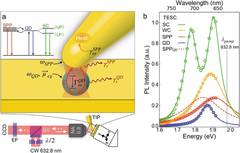Nano-cavity QED with tunable nano-tip interaction
| Reviews and Highlights | Quantum Science | Molecular and Soft-matter | Ultrafast Nano-optics and Nanophotonics | Mineralogy and Geochemistry |
|---|
Molly A. May, David Fialkow, Tong Wu, Kyoung‐Duck Park, Haixu Leng, Jaron A. Kropp, Theodosia Gougousi, Philippe Lalanne, Matthew Pelton, and Markus B. Raschke
Adv. Quantum Technol. 3, 1900087 (2020).
DOI PDF SI

Quantum state control of two‐level emitters is fundamental for many information processing, metrology, and sensing applications. However, quantum‐coherent photonic control of solid‐state emitters has traditionally been limited to cryogenic environments, which are not compatible with implementation in scalable, broadly distributed technologies. In contrast, plasmonic nano‐cavities with deep sub‐wavelength mode volumes have recently emerged as a path toward room temperature quantum control. However, optimization, control, and modeling of the cavity mode volume are still in their infancy. Here recent demonstrations of plasmonic tip‐enhanced strong coupling (TESC) with a configurable nano‐tip cavity are extended to perform a systematic experimental investigation of the cavity‐emitter interaction strength and its dependence on tip position, augmented by modeling based on both classical electrodynamics and a quasinormal mode framework. Based on this work, a perspective for nano‐cavity optics is provided as a promising tool for room temperature control of quantum coherent interactions that could spark new innovations in fields from quantum information and quantum sensing to quantum chemistry and molecular opto‐mechanics.
News & Highlights: JILA
